National Māori flag
The Tino Rangatiratanga flag, also known as the national Māori flag, is used to represent the Māori people of New Zealand. In 2009, the Tino Rangatiratanga flag (also simply Tino) was selected as the national Māori flag after a nationwide consultation. It was first revealed on Waitangi Day in 1990. Though it does not have official status from the New Zealand Government, it has been used by the government on official occasions.[1]
 Tino Rangatiratanga, the national Māori flag | |
| Tino Rangatiratanga | |
| Proportion | 2:3 |
|---|---|
| Adopted | 2009 |
| Design | A flag divided in two by a white koru design, off-centre to the hoist, with a field of black on top and a field of red on bottom. |
| Designed by | Hiraina Marsden, Jan Smith and Linda Munn |
Description
The national Māori flag uses the national colours of New Zealand: black, red ochre, and white or silver. Each of the colours references a realm in the creation story of Māori mythology: black is Te Korekore (potential being), red is Te Whai Ao (coming into being), and white is Te Ao Mārama (the realm of being and light).[1] The design features a koru (Māori for fern frond), a common design in Māori tattoo and sculpture. It symbolises renewal and hope for the future.[2] The white part of the flag is also a reference to the Māori name for New Zealand, Aotearoa, or "Land of the Long White Cloud."[2]
History
Creation
In 1989, the New Zealand government was preparing to celebrate the 150th anniversary of the signing of the Treaty of Waitangi, a historical document between the British colonial government and the indigenous Māori people. In response to this celebration, several Māori independence organizations, including Te Kawariki, sought to raise awareness of the ways in which the treaty had been breached. Te Kawariki, inspired by the Australian Aboriginal Flag, decided to hold a public contest for a design. However, they did not feel any of the contest submissions fitted what they were looking for, artist Hiraina Marsden created her design, that was later sewed by Jan Smith, and Linda Munn and others of Te Kawariki. The artists consulted local Māori in a hui, Jan Smith and other members of Te Kawariki sewed the first Māori flag.[3] The flag was first revealed to the public on 6 February, Waitangi Day, 1990.[4] It quickly gained popularity among Māori.

Use and recognition
A Maori advocacy group, Te Ata Tino Toa, applied for the national Māori flag to fly on the Auckland Harbour Bridge on Waitangi Day beginning in 2008. Initially, Transit New Zealand, the government agency that was responsible for the bridge, declined on the basis that the flag did not represent a country recognised by the United Nations.[5] After campaigning with a number of tactics, including lobbying Transit New Zealand and Parliament,[6] submissions to the Human Rights Commission, and holding an annual 'Fly the Flag' competition,[7] the government agreed to fly a Māori flag provided that there was a consensus on which one to fly. A Māori Party–led promotion and series of hui led to 1,200 submissions, with 80% of participants in favor of the Tino Rangatiratanga flag as the preferred Māori flag.[1]
On 14 December 2009, Prime Minister John Key and Māori Affairs Minister Pita Sharples announced the flag would fly from the Auckland Harbour Bridge and other official buildings (such as Premier House) on Waitangi Day. Key explained that it would not replace the New Zealand flag but would fly alongside it, in recognition of the partnership between the Crown and the Māori since the Treaty of Waitangi, stating: "No changes are being made to the status of the New Zealand flag".[8] The move was met with some criticism, with Monarchy New Zealand describing the move as "potentially divisive", to which Key responded that it symbolised unity and improving race relations.[9]
In the 2015–2016 New Zealand flag referendums, organisers approached the Tino Rangatiratanga flag designers about the possibility of including it as a candidate for a national flag, but the designers declined.[10]
Other Māori flags
 Flag of New Zealand
Flag of New Zealand United Tribes of New Zealand flag
United Tribes of New Zealand flag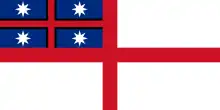 United Tribes of New Zealand flag (black fimbriation variant)
United Tribes of New Zealand flag (black fimbriation variant)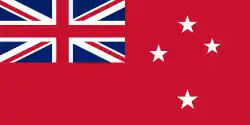 New Zealand Red Ensign
New Zealand Red Ensign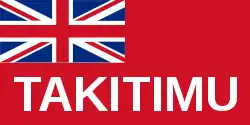
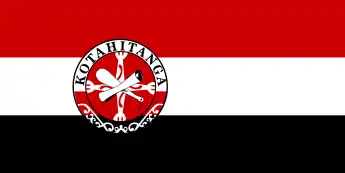 Most popular flag of the Kotahitanga movement
Most popular flag of the Kotahitanga movement Bastion Point flag
Bastion Point flag
New Zealand National Flag
The government of New Zealand continues to recognise the flag of New Zealand as the national symbol of both Māori and non-Māori citizens. According to the Ministry for Cultural Heritage, Tino Rangatiratanga should be flown in a way that "respects the status of the New Zealand flag as the symbol of the Realm, Government and people of New Zealand."[1] When flying from different flag poles, protocol dictates the flags may be the same height. When flying from the same flag pole, the New Zealand national flag must fly on top.[1] It was one of the three other flags considered in the public hui in 2009, along with the United Tribes of New Zealand flag and the Red Ensign. Combined, the three received fewer than a fifth of the public votes.[11]
United Tribes of New Zealand Flag
The flag of the United Tribes of New Zealand (Māori: Te Kara) is a flag selected by a confederation of Māori leaders on 20 March 1834 from among three designs created by British missionary Henry Williams. At the time it was selected, New Zealand was not a colony of the British crown and it was considered the flag of New Zealand. Only later, when the nation became a British colony and the Union Jack its official flag, did this flag become known as the flag of the United Tribes.[12] Though it received few votes in the 2009 hui to select a flag, it had support from a few vocal Māori leaders.[11]
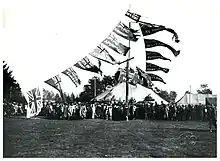
Red Ensign
The Red Ensign is a variant of the New Zealand national flag initially created for use by merchant vessels. Historically Māori have preferred this variant, often flying it rather than the blue ensign at places and occasions of particular Māori significance, and often defacing it with names or symbols of their social groups.[13] The Flags, Emblems, and Names Protection Act of 1981 grants Māori the leave to continue this tradition.[14] It was one of the four flags put to vote in the 2009 public hui.[11]
Kotahitanga flag
A kotahitanga flag is one of any flag designs associated with kotahitanga (English: oneness), a term associated with movements for Māori self-governance beginning in the 1830s.[15] Flags for the movement began appearing in the 1980s and were flown at demonstrations, particularly on Waitangi Day. The most common flag was designed by Norman Te Whata and features a circle, off-centre to hoist, with a mere crossed by a scroll representing the Treaty of Waitangi, with the word "Kotahitanga" above it.[16]
Bastion Point Flag
The Bastion Point flag is a protest flag created by Māori demonstrators to protest the British Crown's occupation of Bastion Point (Māori:Takaparawha) in Auckland, New Zealand. The flag was used in 1977 during the 506 day occupation of the land. It features a mangopare (hammerhead shark) design, representing tenacity.[17] The white of the design references the purity of Ngāti Whātua Ōrākei, the hapū, or sub-tribe, behind the movement. The flag was designed by politician Joe Hawke.[18] It has since been used to memorialise the event and represent other Māori struggles for independence and equality.[19]
References
- "National Māori flag, The". Ministry for Culture and Heritage. 9 February 2021. Retrieved 18 September 2022.
- Marsden, Hiraina; Munn, Linda (1990). "The Maori flag: a symbol of liberation and identity" (PDF). Treaty Resource Centre – He Puna Mātauranga o Te Tiriti. Archived (PDF) from the original on 19 February 2021. Retrieved 21 September 2022.
- "The national Māori flag". nzhistory.govt.nz. Retrieved 18 September 2022.
- "Tino Rangatiratanga". Te Tuhi Mareikura Trust. Retrieved 18 September 2022.
- Transit New Zealand. "Letter: Request for Support (Transit NZ and the Maori flag)" (PDF). Retrieved 14 December 2011.
- Sina Ana Brown-Davis, Spokesperson for Te Ata Tino Toa. "Letter To Dr Sharples About Flying The Maori Flag". Retrieved 14 December 2011.
- "The Maori Flag Flies On Waitangi Day". Scoop.co.nz. Retrieved 14 December 2011.
- Espiner, Colin (14 December 2009). "Maori flag to fly on Waitangi Day". Stuff. Retrieved 19 September 2022.
- "Maori Flag Decision Defended By Prime Minister". Radio New Zealand. 9 December 2009. Retrieved 24 January 2012.
- Arseneau, Therese; Roberts, Nigel S. (16 February 2016). "New Zealand's flag referendums: the story so far". The Constitution Unit Blog. Retrieved 19 September 2022.
- "Maori flag decision defended by PM". RNZ. 15 December 2009. Retrieved 18 September 2022.
- Pollock, Kerryn (20 April 2016). "Flags: New Zealand flag". Te Ara – the Encyclopedia of New Zealand. Retrieved 18 September 2022.
- "Other flags". Ministry for Culture and Heritage. Retrieved 19 September 2022.
- "Flags, Emblems, and Names Protection Act 1981 No 47 (as at 28 October 2021): 9 Use of alternative flags". New Zealand Legislation. Retrieved 19 September 2022.
- Keane, Basil (20 June 2012). "Kotahitanga – unity movements: The first Kotahitanga movements, 1834 to 1840". Te Ara – the Encyclopedia of New Zealand. Retrieved 19 September 2022.
- "The Māori Flag – a Symbol of Liberation and Identity". Mana News. 10 July 2018. Retrieved 18 September 2022.
- "Bastion Point". Museum of New Zealand Te Papa Tongarewa. Retrieved 19 September 2022.
- "He maimai aroha mō Joe Hawke nō Ngāti Whātua Ōrākei". Ministry for Culture and Heritage. Retrieved 19 September 2022.
- Johnston, Martin (25 May 2018). "Sun rises on protest commemoration". The New Zealand Herald. Retrieved 19 September 2022.